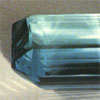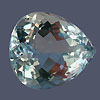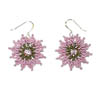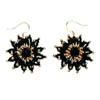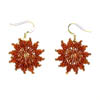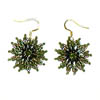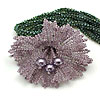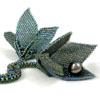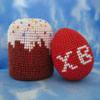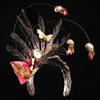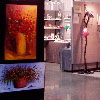March, 2008

From MyLovelyBeads.com TeamWe have already left Valentine's Day behind us, and we are looking forward to Spring! In this issue of MyLovelyBeads.com newsletter:
Aquamarine - blue beryl
Contact us with any questions at
info@mylovelybeads.com.
New on MyLovelyBeads.com Featured artist - Kerrie Slade Types of beads Happy Easter! Easter eggs Step by step - Starflower Earrings March upcoming events Best regards,
MyLovelyBeads.com Team |
Aquamarine - blue berylAquamarine is a gemstone-quality transparent variety of beryl, having a delicate blue, greenish blue to blue green color, typically light in tone, suggestive of the tint of seawater. The name "aquamarine" comes from Latin AQUA MARINA - "water of the sea". It occurs at most localities which yield ordinary beryl, some of the finest coming from Russia. The gem-gravel placer deposits of Sri Lanka contain aquamarine. In the United States, aquamarines can be found in central Colorado. Brazil, Zambia, Madagascar, Malawi, Tanzania, Namibia, Zimbabwe, and Kenya also produce aquamarine, other sources of aquamarine are in Burma, China, India, Australia. The ancient Romans believed that the aquamarine was sacred to Neptune, the god of the sea, having fallen from the jewel boxes of sirens and washed onto shore. Early sailors wore aquamarine talismans, engraved with the likeness of Neptune, as protection against dangers at sea. They believed that it would ensure a safe passage, and guarantee a safe return, and they often slept with the stones under their pillow to ensure sound sleep. They believed the siren's (mermaid) fish-like lower body was made of aquamarine. The association with water led to the belief that the aquamarine was particularly powerful when immersed. Water in which this gemstone had been submerged was used in ancient times to heal a variety of illnesses of the heart, liver, stomach, mouth and throat. People in the Middle Ages thought that aquamarine could magically overcome the effects of poison. A gift of aquamarine symbolizes both safety and security, especially within long standing relationships. Some people even say that the aquamarine reawakens love in a tired marriage. Aquamarine facts 1. Aquamarine is the official state gem of Colorado. 2. The biggest aquamarine ever mined was found at the city of Marambaia, Minas Gerais, Brazil, in 1910. It weighed over 110 kg, and its dimensions were 48.5 cm long and 42 cm in diameter. |
|
New on MyLovelyBeads.comWe are working on our Spring collection. Some of our new items have already been presented on the site in New Items section. We have recently added new articles on jewelry making, here is the short list of articles:
• Beadwoven jewelry by Kerrie Slade
• Jewelry sculpturing by Dawn Vertrees • Kumihimo braiding by Susan Daigle • Silversmithing by Hanna Ben-Nathan |
|
Featured artist
Bead artist Kerrie Slade lives in Nottinghamshire, England and here she shares with us some of her thoughts on inspiration and design in beadwork. Kerrie discovered beads in her late thirties and credits them with changing her life. She knew from the beginning that she wanted to create her own designs in beadwork, but was daunted at first, thinking an artistic background would be needed to be able to make her way in this field. Through hard work and perseverance however, she developed her skills and now has her designs featured in several popular bead magazines. She also sells her original work via craft fairs, galleries and her website. Kerrie is a great believer in pushing both herself and the boundaries in beadwork in order to create interesting and unusual designs. Her advice to anyone just starting out is "Don't take no for an answer - not even from yourself". She has often been called "a perfectionist" and whilst she admits that she still has a lot to learn regarding the actual techniques of beading, she doesn't consider the attention to detail in her work to be a bad thing. She will often spend days or even weeks working on the design of a piece until she is happy with its color, shape and form. The inspiration for her work comes mainly from nature, especially her garden, and she enjoys attempting to recreate her favorite flowers in beadwork. She is also often inspired by an interesting color or finish of beads or an unusual clasp. Her "Hibiscus Twist" necklace for example, was designed wholly around a pretty silver butterfly shaped clasp that caught her eye. Kerrie says she is passionate about beads and beadwork and she is currently experimenting with mixing different stitches and using variations of a stitch in her designs. Please take the time to look at both Kerrie's gallery of work and her website, or read her blog, and feel free to send Kerrie your comment.
Gallery on MyLovelyBeads.com
|
|
Types of beadsA bead is a small, decorative object that is pierced for threading or stringing. Beads range in size from under a millimeter to over a centimeter or sometimes several centimeters in diameter. Glass, plastic, and stone are probably the most common materials, but beads are also made from bone, horn, ivory, metal, shell, pearl, coral, gemstones, polymer clay, metal clay, resin, synthetic minerals, wood, ceramic, fiber, paper, and seeds. A pair of beads made from Nassarius shells that are approximately 100,000 years old are thought to be the first known examples of jewelry. Chevron beads are special glass beads, originally made for the slave trade in Africa by glassmakers in Italy. They are composed of many consecutive layers of colored glass. Dichroic glass beads are high-end art beads. Dichroic glass has a thin film of metal fused to the surface of the glass, resulting in a surface that has a metallic sheen that changes between two colors when viewed at different angles. Ethnic beads are considered trade beads made in West Africa, by and for Africans, such as Mauritanian Kiffa beads, and Ghanaian and Nigerian powder glass beads. Other ethnic beads include Tibetan Dzi beads and African-made brass beads. Rudraksha beads are seeds that are customary in India for making Buddhist and Hindu rosaries (malas). Magatama are traditional Japanese beads, and cinnabar was often used for beads in China. Faux natural beads are made to look like a more expensive original material, especially in the case of fake pearls and simulated rocks, minerals, and gemstones. Precious metals and ivory are also imitated. Fire-polished beads are faceted glass beads made in the Czech Republic. They are faceted by machine and then drawn through ovens to make the surfaces molten, and thus shiny when the beads cool.Furnace (cane) glass beads are made using traditional glassworking techniques from Italy that are more often used to make art glass objects. The manufacture of these beads requires a large glass furnace and annealing kiln. Fusible beads are small, plastic and colorful beads that are placed on a peg array with a solid plastic backing to form pictures and designs and then melted together with a clothes iron. Lampwork beads are made by using a torch to heat a rod of glass and spinning the resulting thread around a metal rod covered in bead release. Lead crystal beads (also known as machine cut crystal) are cut crystal beads made with hi-tech precise machinery. Swarovski along with Preciosa branded crystal beads are the most prized by jewelers and hobbyists. Millefiori (mosaic) beads are made of plain wound glass bead cores and thin slices of cut cane (murrine) which are being pressed into the bead surface, forming mosaic-like patterns, while the glass is still hot.Pressed glass beads are formed by pressing the hot glass into mold to give the bead its shape. Seed beads are uniformly shaped spherical or tube shaped beads ranging in size from under a millimeter to several millimeters. "Seed Bead" is a generic term for any small bead.Trade (slave) beads are various types of beads made in Europe specifically to be used in the slave trade and other trading in Africa. |
|
Happy Easter! Easter eggs
Spring is here and for our another Featured Artist this month, it is her favorite time of year. Natasha Razumova began bead-weaving Easter eggs many years ago as a way to celebrate her favorite holiday. Like Spring, this holiday represents a new life and Resurrection for her. She and her family, including two daughters ages 1 and 4, celebrate the season with their Orthodox faith. As celebration, she includes various themes on her eggs such as churches, birds, animals, and crosses. Originally from Rostov-on-Don, Russia, Natasha Razumova now lives in Bonn, Germany where she has been a resident for 5 years. She tells us that she creates these beautiful Easter eggs not just to share her enjoyment of the holiday with others, but also because it makes her feel relaxed and happy. We hope they make you feel the same way. Please view her work and celebrate Spring with us!
Natasha's work can be seen at her gallery: bead woven Easter eggs gallery. Contact Natasha with any questions at rosa2003@yandex.ru. Visit Natasha's website: www.rosa2003.narod.ru. |
|
Step by stepCarol Holmes, a bead artist from Virginia, USA represents her project of how to create Starflower Earrings using seed beads. She assumes that you are nor a beginner neither an advanced bead weaver. Try "Starflower earrings" with Spring colors and enjoy! Feel free to ask Carol any questions on the project at ambrosian@msn.com. |
|
Upcoming events
March 22 - April 13, 2008 2008 Wearable Expressions International Juried Exhibition of Wearable Art will take place in Los Angeles area, among artists from all over the world are beaded jewelry artists: Zoya Gutina, Tatiana Van Iten, Lana May. To see the list of fiber and jewelry artists click here.
April 9-13, 2008 Juried fine crafts by some of about 120 America's top craft artists. |
© 2010 MyLovelyBeads.com All Rights Reserved.
If you do not want receive our newsletter and you wish to remove your email address from our mailing list, please click the following link to unsubscribe.



